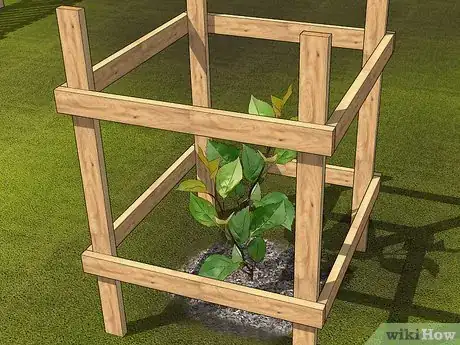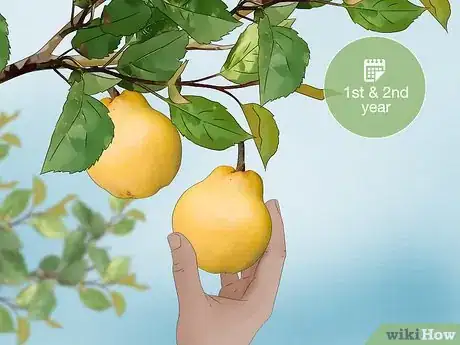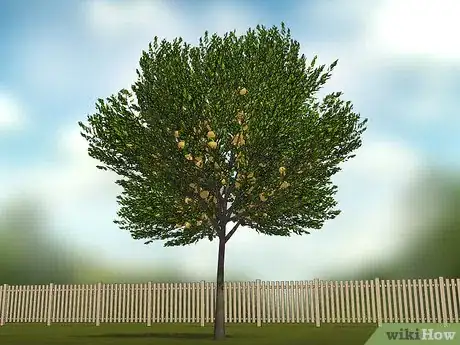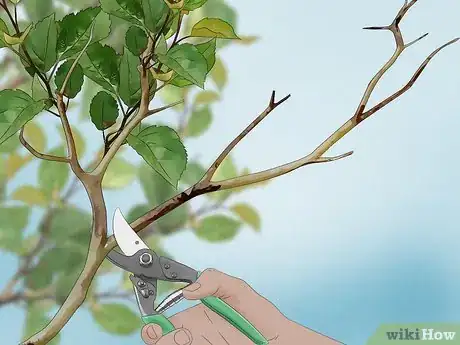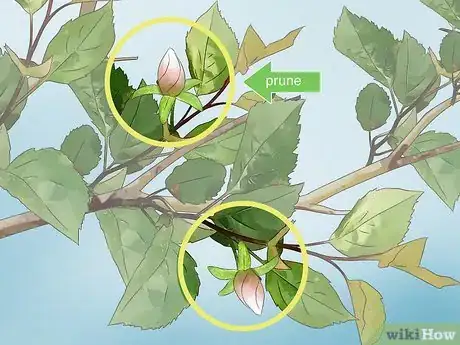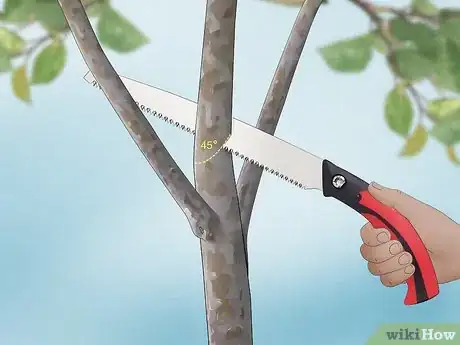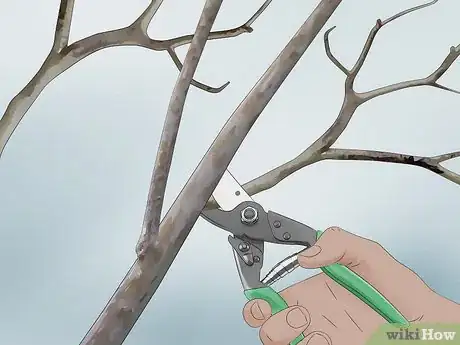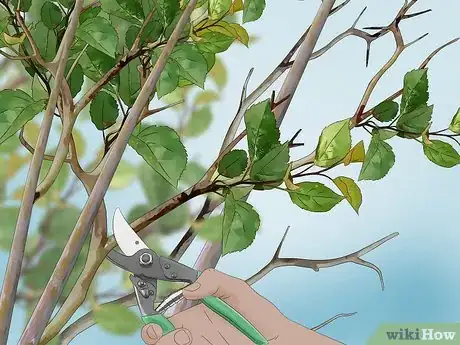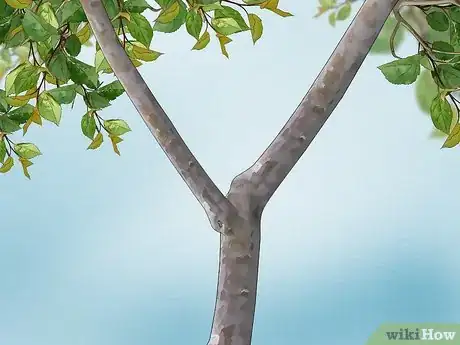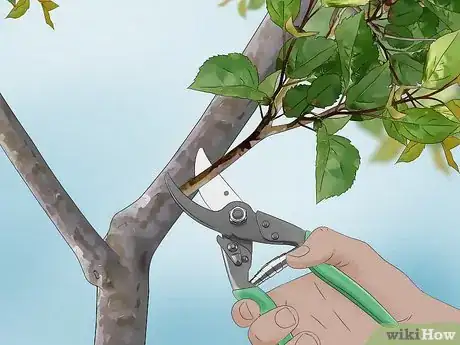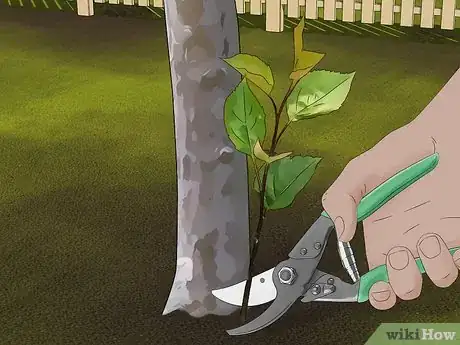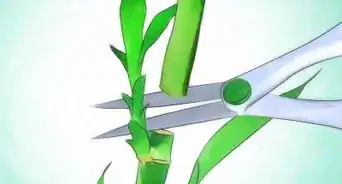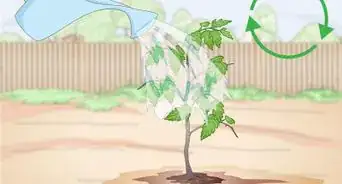This article was co-authored by Maggie Moran and by wikiHow staff writer, Jennifer Mueller, JD. Maggie Moran is a Professional Gardener in Pennsylvania.
There are 12 references cited in this article, which can be found at the bottom of the page.
This article has been viewed 45,590 times.
While many people think of the quince fruit as old-fashioned, interest in this low-maintenance tree has been growing. The hardy quince grows well in nearly any temperate zone, including North America, Europe, Asia, Australia, and New Zealand. While a quince tree requires a bit more attention in its first few years to train it into the right shape, once established, the tree requires relatively little attention and can live for 50 years or longer.[1]
Steps
Training a Young Tree
-
1Support young trees with stakes for 2 or 3 years. Quince fruits need a lot of sun to ripen (at least 6 to 8 hours of direct sunlight each day), so choose a sunny spot to plant your quince tree. Use stakes to help the trunk of your young tree grow straight and tall, and encourage a more balanced root system.[2]
- If you live in a relatively cooler climate, you may want to plant the tree in a more sheltered spot, such as next to a wall, to protect it from strong winds and frost. Just make sure it will still get full sun.
-
2Remove the fruits in the first and second year. The size and weight of ripe quinces can cause young branches to break. It may seem wasteful, but picking the fruit on a young quince tree before it ripens gives the branches time to grow strong enough to support a full crop. Ultimately, you'll have a more productive tree.[3]
- After its second year, your quince tree should be strong enough to bear fruit. Allow the fruit to ripen on the tree as long as possible. Fully ripe quinces typically are harvested just before the first frost.
Advertisement -
3Prune young trees in winter and summer. For the first 3 years, prune in the summer right after the tree has finished fruiting, and then again in winter before the buds start to swell. Always prune on a relatively dry day to reduce the chance of spreading disease or infection.
- After the first year, avoid pruning more than a third of the tree's branches unless the tree is diseased or significantly damaged. You may want to prune a bit more aggressively in the tree's first year to establish the shape in which you want the tree to grow, but try not to take more than 50 percent of the new growth.
- In the summer, prune away any dead or damaged leaves. You may also want to remove foliage that shields the fruits from the sun.
- Each winter, prune back approximately one-third of the new growth from the previous season.[4]
-
4Establish your desired shape in your tree's first year. Quince trees are most commonly shaped in a vase or open-centered goblet style. This shape keeps the center of the tree open, exposing more of the tree to sunlight and allowing more fruits to ripen. Use clean, sharp lopping shears and pruning shears to train the tree into the right shape.[5]
- Choose 3 strong branches that will create your vase shape. These branches should be relatively evenly spaced out. Cut out any branches that cross or compete with your shape.
- As you're pruning, step back often and look at the big picture. In winter, it can help to look at pictures of the tree when it was in full bloom so you know where the growth will likely occur.
-
5Remove dead, diseased, and damaged limbs first. Use pruning shears or lopping shears to cut any damaged or problem branches all the way back to their point of origin, removing them completely. Then work on any branches that are growing vertically, or crossing over other branches.[6]
- Once you've removed all the problem branches, you may find additional pruning isn't necessary, apart from cuts you'll need to make just to train and shape the tree in the first couple of years.
-
6Use the placement of the buds to help train the tree. The weight of the fruit will naturally bend the branch in the direction of the bud. If you want a branch to bend down more, choose a bud on the underside of the branch.
- Make your cuts at a 45-degree angle sloped away from the bud. The bottom of your angle should be just on the other side of the branch from the bud. If you cut too close to the bud, the bud will wither.
- Avoid cutting further up the branch, unless you want to remove the branch completely. You could cause tears on the branch you leave behind. Use a sharp pocket knife to fix any tearing.
-
7Cut the main trunk after the second year. Cutting the main trunk eliminates center growth and encourages the tree further into the vase shape you've created. Cut the trunk of your tree at a 45-degree angle at the height of the highest branch forming your vase. Then prune any other branches cutting into the center space down to their origin.
- You should be able to use a pruning saw to trim off the top of the trunk. A chainsaw can also be used, but be extremely cautious.[7]
Pruning an Established Tree
-
1Prune established trees once in the winter. After your tree is 3 or 4 years old, it only needs to be pruned once a year. Generally, this will be December if you live in the Northern Hemisphere, or July or August in the Southern Hemisphere.[8]
- With older trees, you may be able to get away with pruning every other year. You still want to keep an eye out for dead and unproductive branches on years you don't do a full prune.
-
2Thin crowded and older branches. Quince fruit needs lots of sunlight, but the tree tends to grow in a crowded and haphazard way. It's especially important to cut vertical branches in the center of the tree that threaten to destroy your established shape.[9]
- Older branches that aren't budding or show little growth can be trimmed back completely.
-
3Keep the center of the tree relatively open. Quince trees have a bushy growth pattern that can get messy quickly and destroy the shape and appearance of the tree. After your tree is well-established, the main focus of your pruning should be on clearing the center of the tree and keeping it tidy.[10]
- Remove vertical branches in the center completely to keep the center of the tree from becoming tangled and overgrown.
-
4Cut down unwanted shoots completely. You can trim ends of branches simply to improve the tree's shape. However, if a branch is crossing another or growing up from the center of the tree, remove it.[11]
- Generally, most vertical branches can be removed. If they're not crossing another branch yet, they will eventually. Cutting them all the way down keeps them from growing back in a direction you don't want.
-
5Leave branches that cannot be cut with pruning shears. Unless a branch is dead or diseased, removing a large branch may overly stress your tree and destroy its productivity. If branches with a diameter of more than 2 inches (5.1 cm) are cut, the tree will start growing wood instead of budding and bearing fruit.[12]
- Ideally, cut branches that are growing in the wrong direction early, before they get too large for you to cut.
-
6Remove tree suckers and watersprouts throughout the year. Tree suckers and waterspouts are fast new growths that appear low on the trunk or sprout from the roots of your tree. Because they cannot bear fruit, they will only sap energy from your tree and reduce its productivity.[13]
- Removing them as soon as possible decreases the chances that they will regrow. Aside from this, allowing them to grow means they will continue to take nutrients from your tree.
- Generally, maintain a trunk clearance of 3.5 to 4 feet (1.1 to 1.2 m) on an established quince tree.[14]
Expert Q&A
-
QuestionAre quince fruit edible?
 Maggie MoranMaggie Moran is a Professional Gardener in Pennsylvania.
Maggie MoranMaggie Moran is a Professional Gardener in Pennsylvania.
Home & Garden Specialist Yes, the quince fruit, once ripe, is edible. However, the Japanese quince and the flowering variety are very tart.
Yes, the quince fruit, once ripe, is edible. However, the Japanese quince and the flowering variety are very tart. -
QuestionHow do you know when quince is ripe?
 Maggie MoranMaggie Moran is a Professional Gardener in Pennsylvania.
Maggie MoranMaggie Moran is a Professional Gardener in Pennsylvania.
Home & Garden Specialist There are two easy ways to tell. The first is the color of the fruit—a ripe quince turns totally yellow. The second way is by the smell—ripe quince has a strong, sweet, fragrance.
There are two easy ways to tell. The first is the color of the fruit—a ripe quince turns totally yellow. The second way is by the smell—ripe quince has a strong, sweet, fragrance. -
QuestionHow long does it take for a quince tree to bear fruit?
 Maggie MoranMaggie Moran is a Professional Gardener in Pennsylvania.
Maggie MoranMaggie Moran is a Professional Gardener in Pennsylvania.
Home & Garden Specialist If you have seasonably good weather, it will take between 2-5 years to bear fruit.
If you have seasonably good weather, it will take between 2-5 years to bear fruit.
Things You'll Need
- Wooden stakes (for young trees)
- Pruning shears
- Lopping shears
- Pruning saw
References
- ↑ https://www.stuff.co.nz/life-style/home-property/nz-gardener/77951527/how-to-grow-quinces
- ↑ https://www.starkbros.com/growing-guide/how-to-grow/fruit-trees/quince-trees/location
- ↑ https://www.stuff.co.nz/life-style/home-property/nz-gardener/77951527/how-to-grow-quinces
- ↑ https://www.starkbros.com/growing-guide/article/open-center-pruning-fruit-trees
- ↑ https://www.keepers-nursery.co.uk/quince-trees-advice.htm
- ↑ https://aggie-horticulture.tamu.edu/earthkind/landscape/proper-pruning-techniques/
- ↑ https://aggie-horticulture.tamu.edu/earthkind/landscape/proper-pruning-techniques/
- ↑ https://www.keepers-nursery.co.uk/quince-trees-advice.htm
- ↑ https://www.rhs.org.uk/advice/profile?PID=298
- ↑ https://www.keepers-nursery.co.uk/quince-trees-advice.htm/
- ↑ https://www.dpi.nsw.gov.au/agriculture/horticulture/pomes/other/quince-growing
- ↑ http://www.abc.net.au/gardening/factsheets/pruning-fruit-trees/9440776
- ↑ https://www.starkbros.com/growing-guide/article/fruit-tree-care-removing-suckers-water-sprouts
- ↑ https://www.chrisbowers.co.uk/article/the-ultimate-guide-quinces/
- ↑ https://www.rhs.org.uk/advice/profile?PID=432
